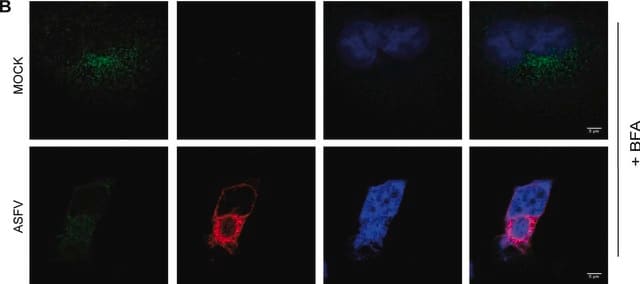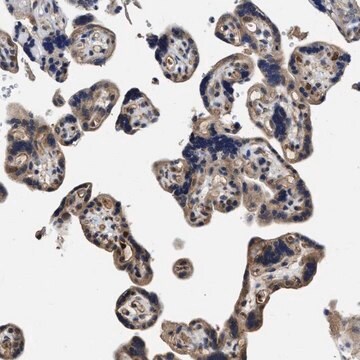推荐产品
生物来源
rabbit
质量水平
偶联物
unconjugated
抗体形式
affinity isolated antibody
抗体产品类型
primary antibodies
克隆
polyclonal
表单
buffered aqueous solution
分子量
antigen 39 kDa
种属反应性
human
技术
immunohistochemistry (formalin-fixed, paraffin-embedded sections): 1:200 using formalin-fixed, paraffin-embedded sections of human colon carcinoma
microarray: suitable
western blot: 1:200 using HeLa nuclear extract
UniProt登记号
运输
dry ice
储存温度
−20°C
靶向翻译后修饰
unmodified
基因信息
human ... JUN(3725)
一般描述
Activation Protein transcription factor 1 (AP-1) is a leucine zipper transcription factor that recognizes a specific palindromic sequence present in several promoters and enhancers. AP-1 can be induced by several growth and apoptosis-related signaling pathways. Jun proteins are also involved in metastatic, inflammatory and stress responses.
Anti-AP-1/c-Jun recognizes an epitope located on the c-Jun DNA binding domain. This epitope is highly conserved in c-Jun, Jun B and Jun D proteins of chicken, mouse, rat, and human. By immunoblotting, the antibody reacts specifically with AP-1/c-Jun (a single band or occasionally a doublet at 39kDa region). Additional bands of lower molecular weight may be observed. Staining of AP-1/c-Jun band(s) is inhibited by the AP-1/c-Jun immunizing peptide (amino acid residues 246-263).
Anti-AP-1/c-Jun recognizes an epitope located on the c-Jun DNA binding domain. This epitope is highly conserved in c-Jun, Jun B and Jun D proteins of chicken, mouse, rat, and human. By immunoblotting, the antibody reacts specifically with AP-1/c-Jun (a single band or occasionally a doublet at 39kDa region). Additional bands of lower molecular weight may be observed. Staining of AP-1/c-Jun band(s) is inhibited by the AP-1/c-Jun immunizing peptide (amino acid residues 246-263).
免疫原
synthetic peptide corresponding to amino acids 246-263 of human c-Jun with N-terminally added lysine, conjugated to KLH.
应用
Anti-AP-1 antibody has been used in
- immunohistochemistry
- immunochemistry
- western blotting
Immunofluorescence of Hela cells was performed using monoclonal anti-AP1 (clone 100/3) as the primary antibody.
生化/生理作用
Activation Protein transcription factor 1 (AP-1) recognizes a specific sequence (TPA response element, a palindromic TRE sequence TGA(C/G) TCA or related sequences) present in many promoter and enhancer gene regions. Regulation of AP-1 is achieved by changes in the expression of Jun and Fos proteins in the dimer, by phosphorylation at both Ser63 and Ser73 by c-Jun N-terminal kinases (JNK) and by interaction with a variety of transcriptional coactivators like C-Jun activation domain-binding protein-1 (JAB1). AP-1 is induced by a variety of signals including those eliciting proliferation, differentiation and apoptosis.
外形
Solution in 0.01 M phosphate buffered saline, pH 7.4, containing 1% bovine serum albumin and 15 mM sodium azide.
免责声明
Unless otherwise stated in our catalog or other company documentation accompanying the product(s), our products are intended for research use only and are not to be used for any other purpose, which includes but is not limited to, unauthorized commercial uses, in vitro diagnostic uses, ex vivo or in vivo therapeutic uses or any type of consumption or application to humans or animals.
未找到合适的产品?
试试我们的产品选型工具.
储存分类代码
10 - Combustible liquids
WGK
WGK 3
闪点(°F)
Not applicable
闪点(°C)
Not applicable
历史批次信息供参考:
分析证书(COA)
Lot/Batch Number
其他客户在看
AP-1 as a regulator of cell life and death
Shaulian E and Karin M
Nature Cell Biology, 4(5), E131-E131 (2002)
Yongshun Tan et al.
Cell biology international, 45(8), 1654-1665 (2021-03-25)
TET1 mediates demethylation in tumors, but its role in diabetic nephropathy (DN), a prevalent diabetic complication, is unclear. We attempted to probe the possible mechanism of TET1 in DN. A DN rat model was established and verified by marker detection and
Swathy Krishna et al.
Frontiers in physiology, 14, 1152576-1152576 (2023-05-14)
Duchenne muscular dystrophy (DMD) is a progressive muscle disease that results in muscle wasting, wheelchair dependence, and eventual death due to cardiac and respiratory complications. In addition to muscle fragility, dystrophin deficiency also results in multiple secondary dysfunctions, which may
Adaptor and Clathrin Exchange at the Plasma Membrane and trans-Golgi Network.
Xufeng, W.
Molecular and Cellular Biology, 14, 516-528 (2002)
AP-1 function and regulation
Karin M, et al.
Current Opinion in Cell Biology, 9(2), 240-246 (1997)
我们的科学家团队拥有各种研究领域经验,包括生命科学、材料科学、化学合成、色谱、分析及许多其他领域.
联系技术服务部门









